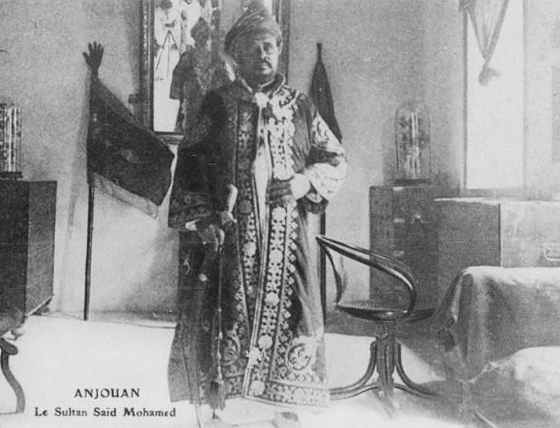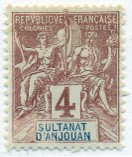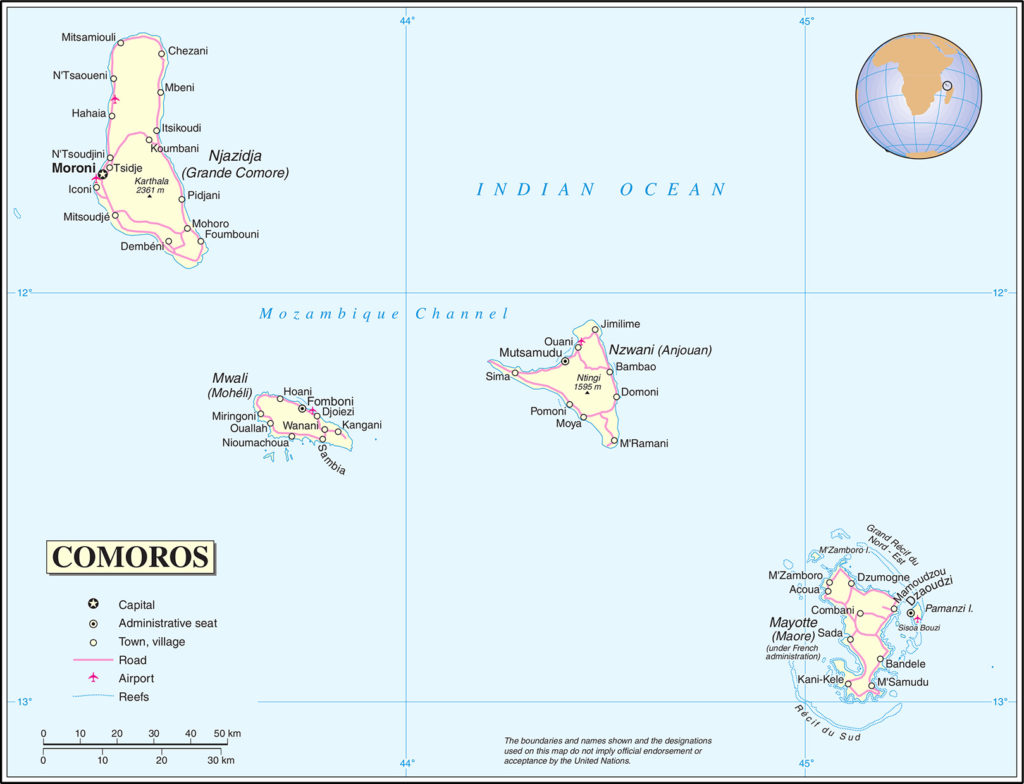ALBUM – view my Sultanate of Anjouan album
Fast Facts
Region: East Africa / Madagascar
Group: Comoro Islands
Classification: French Colony
Prior Regime: Sultanate of Anjouan (independent)
Key Dates:
1841, Mar 25 – France establishes colony on Mayotte
1878, Apr 21 – Anjouan becomes a French Protectorate
1908 – Anjouan is folded into the colony of Mayotte and its Dependencies
1909 – The Sultan of Anjouan abdicates to French rule
11912, Jul 25 – Anjouan is annexed by France into Madagascar
Following Regime: Colony of Mayotte and Dependencies
First Stamp Issued: 1892
Scott Catalogue: (Anjouan) 1-30
Pick Catalogue: N/A
History

The Comoros are a chain of volcanic islands located between northern Madagascar and the African continent. The Comoros were ruled by local sultans since the arrival of Islam in the 15th century, the islands, especially Ndzuwani (Anjouan in French) became a major supply port for ships in route to the East.
As the major colonial powers flexed their muscles in Africa, both the French and British looked towards the Comoros for potential territory. Eventually, the French purchased the island of Maore (Mayotte in French) on March 25th 1841 and it became a French Colony.
With its foothold in the Comoros, France found that they were quickly caught up in between the frequent wars among the ruling sultans. For a time, the British exerted influence in the Comoros, and attempted to abolish slavery on Anjouan in 1882. In response, Sultan Saidi Abdallah bin Salim of Anjouan turned to France for protection, and eventually on April 21, 1886 the Sultan of Anjouan agreed to become a protectorate of France, which was shortly followed by the other islands of the Comoros (Grand Comoro and Moheli).
French power and influence increased on the islands with the introduction of concessionary companies to take over control of arable land for agricultural plantations. Eventually the sultans became mere puppets of the Concession companies. In 1907, La Société Coloniale de Bambao was formed to operate concessions on the lands of the Sultan of Anjouan. The following year, France unified the Comoros under a single administration called as the Colonie de Mayotte et Dépendances, This colony was placed under the authority the French colonial governor general of Madagascar.
In 1909, Sultan Said Muhamed of Anjouan abdicated and turned over rule to the French. Eventually, in 1912 the last of the Sultans resigned and the islands became a province of the colony of Madagascar
Stamps
 ALBUM
ALBUM
The first stamps for Anjouan were issued in 1892 with the release of the French Commerce and Navigation series across all French colonies and territories. The common design stamps featured the allegorical figures of Commerce and Navigation and was printed on various paper colors. Each stamp had a blank tablet at the bottom of the design where the name of the territory was added.
For Anjouan, eleven denominations were issued in 1892 with “SULTNAT D’ANJOUAN” printed in the tablet. In 1900, four denominations were re-issued in different colors (10c, 15c, 25c and 50c). This was later followed by two additional denominations, 35c in 1906 and the 45c in 1907. For collectors, the 45c stamp is the most expensive, and more difficult stamp to acquire.
The stamps of Anjouan were also used in Moheli until 1906.
In 1912, when the Comoros were annexed into Madagascar, the remainder stamps of Anjouan were surcharged “05” or “10” in large numbers in black or red. The stamps were used throughout the Comoros until they were replaced by those of Madagascar in 1914.
With many stamps of the classical era, forgeries exist. However, for Anjouan (as well as other countries using the Navigation and Commerce series) it is rather easy to identify the most common forgeries, created by François Fournier. Here are three ways to identify the most common Anjouan forgeries. 1) Perforation: the genuine stamps are perf 14 x 13.5, while the forgeries are 13.5 x 14. 2) The fingers on the hand holding the flag in the upper middle are clear, while on the forgery they are almost a blob. 3). The small fruit in lower left of the cornucopia is distinct from the rim, while the small fruit blends into the rim in the forged stamps. See my ALBUM for examples.
Banknotes
Banknotes of the French Colonies were used in Anjouan and the Comoros.
Links
History of Anjouan at Anjouan.net
Stamps of Anjouan from Big Blue 1840-1940






Michael –
I really like your Fournier forgery detection closeups – Nice!
Do you have some Fournier Navigation and Commerce fakes in your collection?
Jim
Hi Jim
Thanks
I do have a couple of Fournier Navigation and Commerce forgeries, but not for Anjouan.
Michael